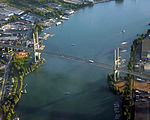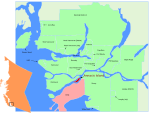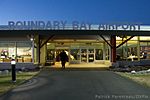Burns Bog

Burns Bog is an ombrotrophic peat bog located in Delta, British Columbia, Canada. It is the largest raised peat bog and the largest undeveloped urban land mass on the West Coast of the Americas. Burns Bog was originally 4,000–4,900 hectares (9,900–12,100 acres) before development. Currently, only 3,500 hectares (8,600 acres) remain of the bog.Burns Bog is habitat to more than 300 plant and animal species, and 175 bird species. Some of these animals are listed as endangered (i.e. red-listed) or vulnerable (i.e. blue-listed) under the BC Provincial Government Species at-risk designations. The bog is also a major migratory stopover for various bird species on the Pacific Flyway.Burns Bog regulates water as well. The bog prevents flooding, maintains cool water temperatures in nearby rivers, holds water, and releases water in dry conditions. Burns Bog is an estuarine bog since it is situated at the mouth of the Fraser River and next to the Pacific Ocean.
Excerpt from the Wikipedia article Burns Bog (License: CC BY-SA 3.0, Authors, Images).Burns Bog
Delta Tilbury
Geographical coordinates (GPS) Address Nearby Places Show on map
Geographical coordinates (GPS)
| Latitude | Longitude |
|---|---|
| N 49.120833333333 ° | E -122.97361111111 ° |
Address
Tilbury
V4G 1G6 Delta, Tilbury
British Columbia, Canada
Open on Google Maps




